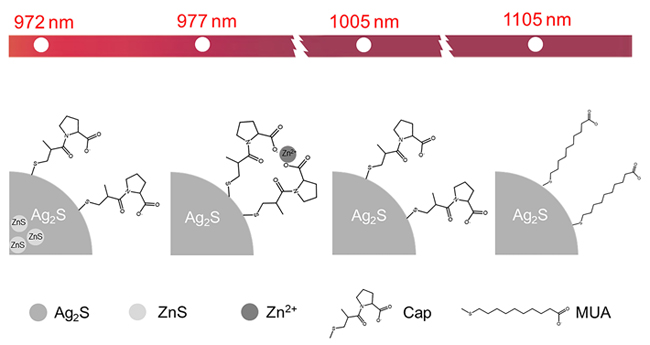| [1] |
Sang, R.; Xu, X.; Wang, Q.; Fan, Q.; Huang, W. Acta Chim. Sinica 2020, 78, 901. (in Chinese)
doi: 10.6023/A20050190
|
|
(桑若愚, 许兴鹏, 王其, 范曲立, 黄维, 化学学报, 2020, 78, 901.)
doi: 10.6023/A20050190
|
| [2] |
Zhang, M.; Yue, J.; Ran, C.; Ma, Z.; Dai, H. Proc. Natl. Acad. Sci. Belarus-Agrar. Ser. 2018, 115, 201806153.
|
| [3] |
Gao, G.; Gong, D.; Zhang, M.; Sun, T. Acta Chim. Sinica 2016, 74, 363. (in Chinese)
doi: 10.6023/A16010038
|
|
(高冠斌, 龚德君, 张明曦, 孙涛垒, 化学学报, 2016, 74, 363.)
doi: 10.6023/A16010038
|
| [4] |
Alivisatos, A. P. Science 1996, 271, 933.
doi: 10.1126/science.271.5251.933
|
| [5] |
Niu, Z. Natl. Sci. Rev. 2017, 4, 167.
doi: 10.1093/nsr/nwx020
|
| [6] |
Mo, D.; Hu, L. Zeng, G.; Chen, G.; Wan, J.; Yu, Z.; Huang, Z.; He, K.; Zhang, C.; Cheng, M. Appl. Microbiol. Biotechnol. 2017, 101, 2713.
doi: 10.1007/s00253-017-8140-9
|
| [7] |
Zhu, J.; Tang, Y.; Wang, G.; Mao, J.; Liu, Z.; Sun, T.; Wang, M.; Chen, D.; Yang, Y.; Li, J.; Deng, Y.; Yang, S. ACS Appl. Mater. Interfaces 2017, 9, 14470.
doi: 10.1021/acsami.6b11525
|
| [8] |
Feng, Y.; Wang, X.; Huang, J.; Dong, P.; Wang, C. Chem. Eng. J. 2020, 390, 124525.
doi: 10.1016/j.cej.2020.124525
|
| [9] |
Murray, C. B.; Norris, D. J.; Bawendi, M. G. J. Am. Chem. Soc. 1993, 115, 8706.
doi: 10.1021/ja00072a025
|
| [10] |
Hocaoglu, I.; Natali, M.; Erdem, R.; Ozen, C.; Kurt, A.; Sennaroglu, A.; Acar, H. J. Mater. Chem. 2012, 22, 14674.
doi: 10.1039/c2jm31959d
|
| [11] |
Du, Y.; Xu, B.; Fu, T.; Cai, M.; Li, F.; Zhang, Y.; Wang, Q. J. Am. Chem. Soc. 2010, 132, 1470.
doi: 10.1021/ja909490r
|
| [12] |
Luo, X.; Chen, M.; Yang, Q. Acta Chim. Sinica 2020, 78, 373. (in Chinese)
doi: 10.6023/A20020045
|
|
(罗兴蕊, 陈敏文, 杨晴来, 化学学报, 2020, 78, 373.)
doi: 10.6023/A20020045
|
| [13] |
Wang, J.; Yang, F.; Gao, G.; Sun, T. J. Inorg. Mater. 2019, 34, 1156.
|
|
(王君诚, 杨菲菲, 高冠斌, 孙涛垒, 无机材料学报, 2019, 34, 1156.)
|
| [14] |
Gan, Z.; Liu, Y.; Wang, L.; Jiang, S.; Xia, N.; Yan, Z.; Wu, X.; Zhang, J.; Gu, W.; He, L.; Dong, J.; Ma, X.; Kim, J.; Wu, Z.; Xu, Y.; Li, Y.; Wu, Z. Nat. Commun. 2020, 11, 5572.
doi: 10.1038/s41467-020-19377-6
|
| [15] |
Guo, J.; Guo, M.; Wang, F.; Jin, W.; Chen, C.; Liu, H.; Li, Y. Angew. Chem., Int. Ed. 2020, 59, 16712.
doi: 10.1002/anie.v59.38
|
| [16] |
Thiessen, A. N.; Zhang, L.; Oliynyk, A. O.; Yu, H.; O'Connor, K. M.; Meldrum, A.; Veinot, J. G. C. Chem. Mater. 2020, 32, 6838.
doi: 10.1021/acs.chemmater.0c00650
|
| [17] |
Medintz, I. L.; Uyeda, H. T.; Goldman, E. R.; Mattoussi, H. Nat. Mater. 2005, 4, 435.
pmid: 15928695
|
| [18] |
Valizadeh, A.; Mikaeili, H.; Samiei, M.; Farkhani, S. M.; Zarghami, N.; Kouhi, M.; Akbarzadeh, A.; Davaran, S. Nanoscale Res. Lett. 2012, 7, 480.
doi: 10.1186/1556-276X-7-480
pmid: 22929008
|
| [19] |
Peng, Z. A.; Peng, X. J. Am. Chem. Soc. 2001, 123, 183.
pmid: 11273619
|
| [20] |
Anc, M. J.; Pickett, N. L.; Gresty, N. C.; Harris, J. A.; Mishra, K. C. ECS J. Solid State Sci. Technol. 2013, 2, 3071.
|
| [21] |
Xu, Y.; Zhao, Y.; Zhang, Y.; Cui, Z.; Wang, L.; Fan, C.; Gao, J.; Sun, Y. Acta Chim. Sinica 2018, 76, 393. (in Chinese)
doi: 10.6023/A18010039
|
|
(徐毅, 赵彦, 张叶俊, 崔之芬, 王丽华, 樊春海, 高基民, 孙艳红, 化学学报, 2018, 76, 393.)
doi: 10.6023/A18010039
|
 ), 孙涛垒a,b,*(
), 孙涛垒a,b,*( )
)
 ), Taolei Suna,b(
), Taolei Suna,b( )
)
